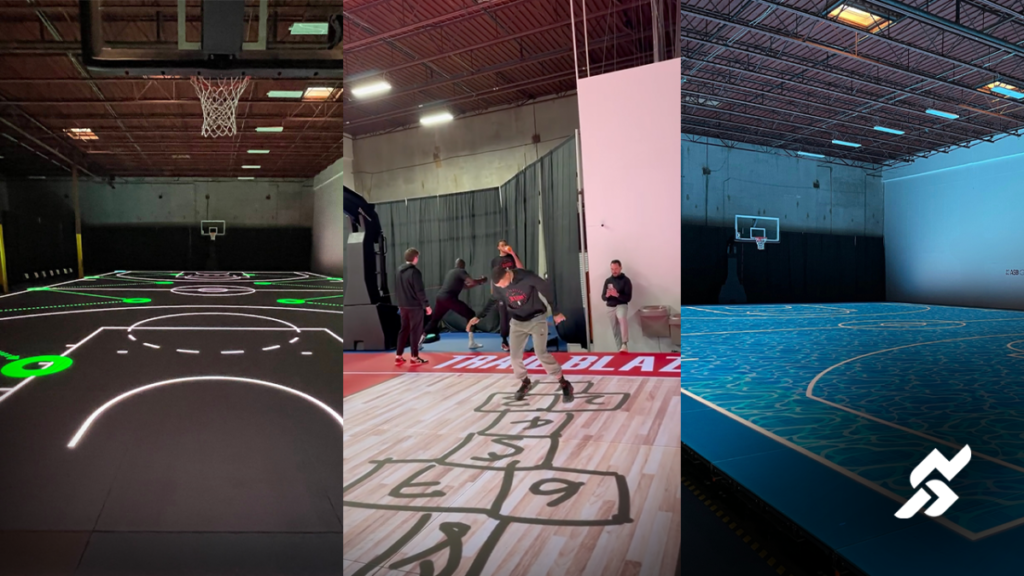A year after ASB GlassFloor’s debut during the 2024 NBA All-Star Weekend, the company has set up a temporary testing facility in Orlando, Fla., eager to expand its U.S. footprint.
Multiple NBA teams in town to play the Magic have since tried the tech as the league explores future applications. Trail Blazers player Deni Avdija used an iPad to sketch hopscotch squares onto the court (as well as his own face). Pistons coach J.B. Bickerstaff’s mug replaced the midcourt logo when Detroit showed up a couple days later. Otherwise, the floor can mimic out-of-town visitors’ own home arenas—or present more abstract designs. But the minds behind ASB GlassFloor envision many more use cases than party tricks and pranks.
More from Sportico.com
ASB’s origins as a design and construction company date back to 1965, including a run as a leader in squash court production. It began focusing on glass sport floors in 2006, with the first full LED floor launching in 2016, as Christof Babinsky took over for his father atop the company, headquartered in Germany. ASB envisions its technology in everything from art installations to airport stores, though sports remain at the heart of the company’s ambitions.
An aluminum and steel skeleton gives the floor a durable spine, while ceramic layers and laser-etching of the glass provide grip. Glass made its biggest stateside splash last year, serving the NBA during its All-Star celebrity game, skills competitions and dunk contest events in Indianapolis.
“It was a ‘wow’ sort of thing,” NBA SVP and head of on-court and brand partnerships Christopher Arena said in a phone interview. “Your mind just runs wild with what it could become.”
The league took a minority stake in ASB’s American subsidiary at the same time.
“We want to be a competitive court used for the biggest events in the NBA and the NCAA,” ASB director of the Americas Chris Thornton said.
ASB believes its court can provide hoopers a more consistent surface than hardwood. Coaches can draw plays directly onto the playing area during practices using the company’s app, while ASB also speaks with third-party data companies capable of collecting and displaying player information from the floor. One day, players might be able to look down and see their own heart rate data, pulled from their wearable devices. Floor panels could light up when a ball or foot steps out of bounds, just like the shot clock does as the buzzer sounds.
Then there are the opportunities for viewer engagement, both in-venue and on TV, and the ad sales possibilities that come with them. While teams and networks have found ways to place virtual logos on their wood courts, light-up glass would let them go further. Free throws, 3-pointers and dunks could all have their own sponsors, with their placements visible to everyone from fans in the stands to those watching the highlights the next day.
“We have far-reaching plans in the area of advertising in basketball,” Babinsky said last year.
The NBA and its teams could also extend their own branding efforts, creating custom courts that match unique jerseys or implementing league-wide displays for special events.
European clubs in Athens and Munich permanently installed GlassFloor’s LumiFlex court ahead of the 2024-25 season, with Panathinaikos GM Stavros Ntinos recently saying that he’s noticed “a decrease in complaints about soreness or discomfort that players typically experience after intense games.” When the court isn’t playing animated designs, it can also resemble a more standard floor.
Arena has discussed the glass floor making its next NBA appearance at other one-off events such as the NBA Cup final. Aside from the NBA, leaders in pickleball, volleyball and college basketball have also toured the Orlando facility, Thornton said.
ASB is still working to accelerate the court’s installation process (it currently can be put in over the course of 18 hours, while traditional courts can come and go in less than three), which would be pivotal for use in arenas shared by hockey teams or other tenants.
And it continues collecting player feedback in Orlando. Their comfort with the tech—and ultimate signoff—will come before the glass ever appears in an NBA game. But many onlookers have already been impressed by the potential.
“What struck me more than anything, when you walk into the facility and you see a team working out—if you close your eyes, you hear the squeaks just like you would on a wood floor,” Arena said. “And then you open your eyes, and you’re like, ‘Wow.’”
Best of Sportico.com
Sign up for Sportico’s Newsletter. For the latest news, follow us on Facebook, Twitter, and Instagram.
Read the full article here



